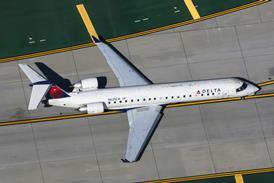GUY NORRIS / LOS ANGELES DATA COMPILED BY DAVID REYNOLDS & BRANDON NOTHNAGEL / AIR TRANSPORT INTELLIGENCE
Engine makers continue to stake their prospects on new programmes as hopes of a 2003 recovery recede
California's Mojave desert is a study in contrasts for the struggling commercial engine business. On the positive side, Mojave has been home to flight tests of the newest engine in the sky, General Electric's GE90-115B, which is being put through its paces in the run up to its certification for the Boeing 777-300ER. Every time the testbed takes off, however, it casts a shadow over the growing fleet of stored aircraft at Mojave and nearby Victorville.
Despite some optimistic belief that the mothballing maelstrom will clear the way for a much-needed purging of the ageing fleet, the short and mid-term reality is nothing but bad news for the engine makers. Every stored aircraft, and their sealed up engines, represents lost revenue from spares, overhaul and maintenance. Every stored aircraft also pushes residual values lower, further depressing the market for virtually every sector except freighter conversions. Even if many of the stored fleet are grounded forever, who knows when or even if such a cathartic experience will produce a wave of fresh orders? Some had hoped there might be signs of such a recovery next year but most now believe it will not now be until 2004 or 2005.
On the face of it, the situation could be worse. Western engine makers still hold orders for around 7,600 powerplants for some 3,600 commercial aircraft currently on firm order. Of these almost 900 are high-value turbofans for Boeing 747-400s, Airbus A340-500/600s and A380s; more than 360 are for Boeing 777s; 500 for widebody Airbus twins; and more than 80 for the commercial Boeing 767 backlog. The balance is made up of smaller engines ranging from more than 120 turboprops to over 3,500 CFM56s and V2500s for Airbus and Boeing aircraft, 500 Rolls-Royce AE3007 and BR715 engines for the smaller Embraer ERJ variants and Boeing 717, and almost 1,200 GE CF34s for Bombardier and Embraer regional jets.
However, while these figures appear substantial, the order pipeline has slowed to a trickle and securing new business for 2003 onwards is the urgent priority for airframers and engine makers alike. The hope is that fresh orders will coincide with the recall of some stored aircraft, and the resurgence of the spares and overhaul revenue stream.
The vagaries of the business in 2002 are nowhere more evident than in the saga of Boeing's Sonic Cruiser. At first this appeared as a beacon of hope for the engine makers as a rare opportunity for the development of exotic new technology and the opening of a new, high-value market. The voice of the airlines has been heard, however, and the engine manufacturers focus is shifting with that of Boeing's towards a "Super Efficient Airplane" formerly known as Project Yellowstone. It remains very early days but the onus appears to be on ultra-efficient, advanced technology engines with higher bypass ratios than ever before. One grain of comfort for engine makers on both sides of the Atlantic is that both ongoing NASA and European research initiatives are aimed at the goals for the Super Efficient design rather than those of the Sonic Cruiser. The next year should therefore decide where the main commercial engine focus will be for the rest of the decade, and possibly beyond.
Source: Flight International























